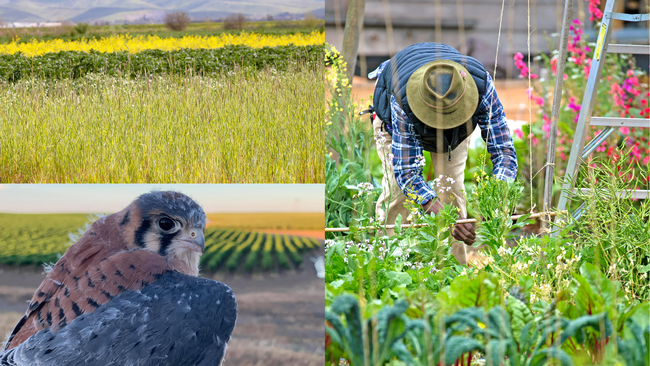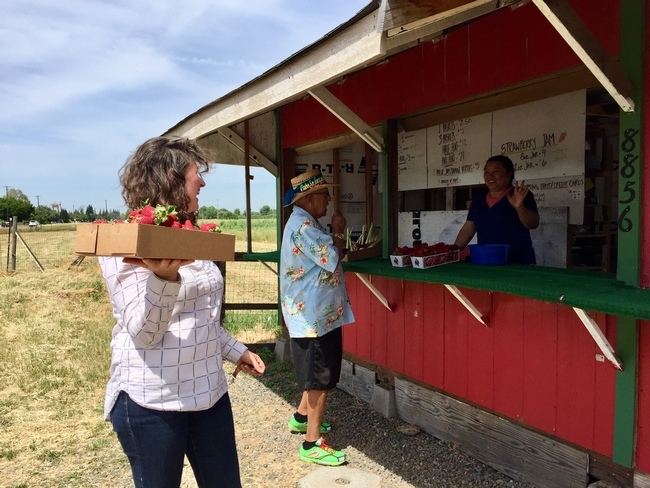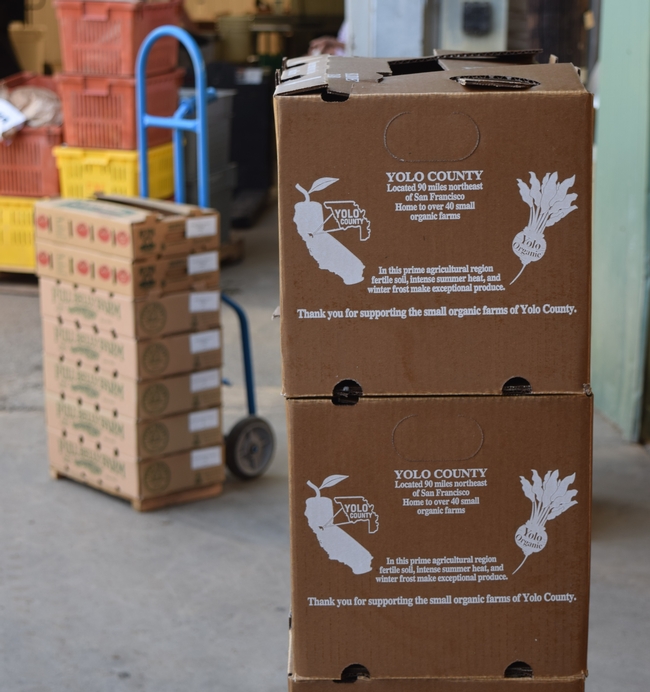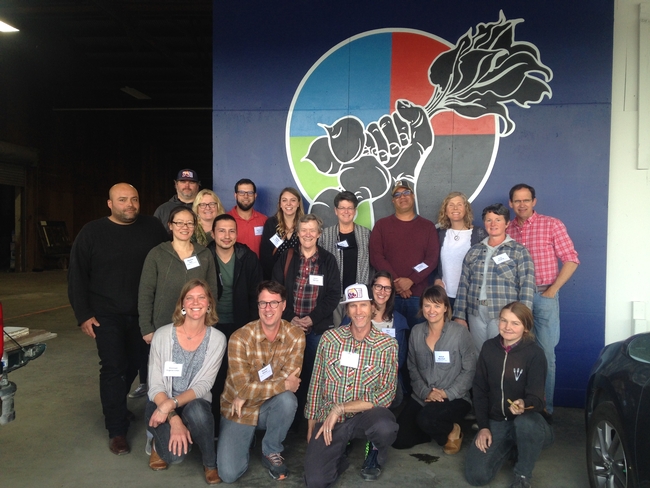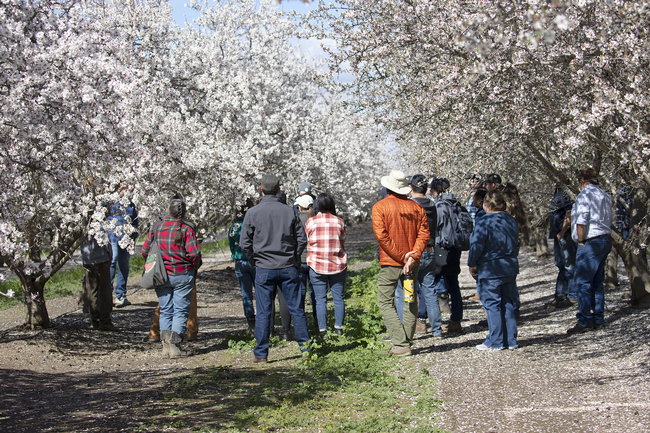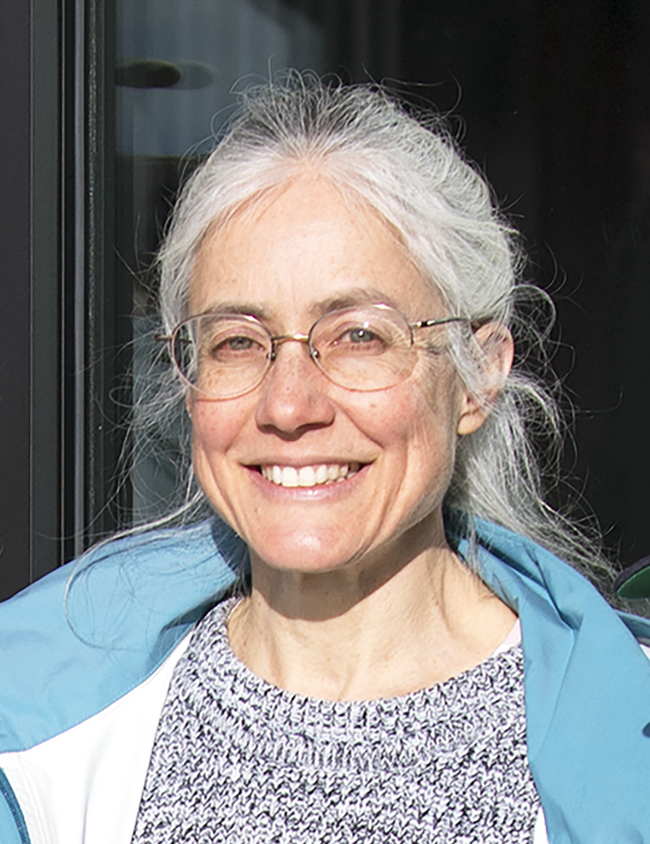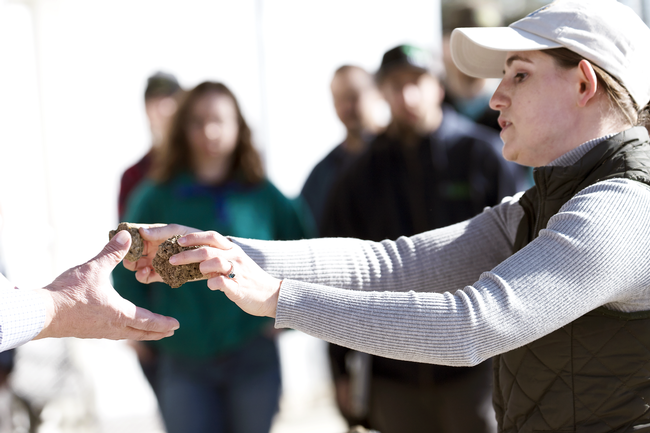Posts Tagged: Sustainable Agriculture Research
Lawn-pocalypse! Surviving Drought
Ah, summer! The season of sunburns, pool parties, and… lawn droughts. If your once lush, green carpet now looks like a crunchy brown doormat, you're not alone. Let's dive into why your yard is staging a dramatic death scene and what you can do to...

Bermuda grass and weeds overtaking drought stressed turf grass.
UC SAREP funds 8 sustainable food and farming projects
Projects will support socially disadvantaged farmers, increase urban access to healthy food and more
The UC Sustainable Agriculture Research & Education Program (SAREP) is pleased to announce the recipients of the Sustainable Agriculture and Food Systems 2024-25 Small Grants Program. This grant program will fund planning, research and education projects that support the development of sustainable community food systems and environmentally sound and economically viable farming enterprises.
Of the 33 eligible applications, eight applicants were selected to receive approximately $80,000 in combined funding to support their work. Individual grants are limited to $10,000. “The Small Grants Program is an important part of our mission,” said Ruth Dahlquist-Willard, interim director of UC SAREP. “By facilitating these grants, SAREP is able to support ANR in engaging a wide range of food systems stakeholders, outcomes show that a small financial investment can have a large impact in improving the lives of Californians.”
The eight recipients of this year's grants are:
Planning
Building Capacity and Resiliency Among Networks of Socially Disadvantaged California Farmers
Fresh Approach will establish a network of pooled learning and technical support that will aid emerging food-aggregation businesses in accessing sustainable market channels, including emergency food distribution. As part of the project, they will enhance an interactive GIS mapping tool of value chains to streamline market opportunities for socially disadvantaged farmers and aggregators. (Project lead: Andy Ollove, Fresh Approach)
Sustainable Urban Resident Food Gardens Expansion Planning Project
Growing Hope Gardens will systematize the process of outreach, discovery, design, planning and implementation in creating new urban resident food gardens. The project will document Growing Hope Gardens' garden development process into a training and implementation manual to more effectively duplicate food garden programs in more low-income urban communities. (Project lead: Carolyn Day, Growing Hope Gardens)
Research
Evaluating Best Management Practices for Cover Crops to Minimize Nitrogen Losses in California's Salinas Valley
This project will quantify the effectiveness of cover cropping at different planting times and termination dates to scavenge excess nitrogen in the soil and reduce nitrate leaching in a Salinas vegetable cropping system. The results will inform Ag Order 4.0 for cover crop credits and help stakeholders in the Salinas Valley better understand crop management for efficient nutrient cycling. (Project lead: Scott Fendorf, Stanford University)
Implications of American Kestrel Diet, Dispersal and Migration on Pest Control in Northern California Farming Systems
Investigators will study how the diet, post-breeding dispersal, and migration of nesting kestrels influences biological pest control on Northern California farms. The project will generate management recommendations for using the predatory bird for biological pest control in sustainable agriculture programs across California. (Project lead: Breanna Martinico, UC Cooperative Extension)
Education and Outreach
EAT! Community Farms Market Access and Promotion Project
This project helps socially disadvantaged and indigenous farmers in Riverside County create pathways for realizing economic return. EAT! will provide mentoring for marketing strategy development, connect farmers to buyers, promote the farmers market so it's more profitable for farmers, and provide a cooperative farm stand in the city of Norco for farmers to sell produce directly to consumers. (Project lead: Patrick Mitchell, Ecological Agricultural Training Cultural Center [EAT!])
Cultivating Cooperative Education, Stewardship and Connection at the Agroecology Commons Cooperative Incubator Farm
Agroecology Commons aims to address challenges faced by young, first-generation, BIPOC, queer and femme farmers at the Agroecology Commons Cooperative Incubator Farm in the Bay Area. The project will focus on education and outreach, providing technical assistance and training in regenerative agriculture practices such as soil health, pest management and crop diversification to socially disadvantaged farmers. (Project lead: Jeneba Kilgore, Agroecology Commons)
Signage and Mural Refurbishment for Southeast Asian Farmers to Improve Direct-to-Consumer Marketing
This project will build new, long-lasting farm signs for Southeast Asian farmers growing diversified vegetables and berries in the Sacramento region. Improving the appeal and durability of farm signs will increase the profitability of the farm stands as these resource-limited farmers rely on direct-to-consumer marketing strategies to promote their businesses. (Project lead: Margaret Lloyd, UC Cooperative Extension)
Community Nutrition Security and Education Program
Farm Discovery at Live Earth will increase access to organic produce for individuals and families experiencing food and nutrition insecurity in the Santa Cruz and Monterey Bay area. This will be accomplished through farming, outdoor education and nutrition education programs focusing on regenerative agricultural practices to connect youth and families to their regional agricultural and ecological systems. (Project Lead: Jessica Ridgeway, Farm Discovery at Live Earth)
The UC SAREP Small Grants Program has a big impact! Help us fund more projects that support sustainable community food systems and environmentally sound, economically viable farming enterprises. To support this program, please donate here. Choose SAREP Small Grants Program for the designation.
Winter season: A time for food safety systems re-evaluation and education for food hubs
The holiday meal season is often a busy time for food hubs – entities that handle the aggregation, distribution and/or marketing of source-identified regional food – as restaurants, retailers and consumers fill their tables and shelves with an abundance of fresh, local products. However, the subsequent winter months can provide a valuable time for reflection and re-evaluation of a food hub's systems and processes. In this spirit, it may be helpful to remind people working at food hubs that University of California Sustainable Agriculture Research and Education Program (UC SAREP) offers a suite of food-safety resources – in English and in Spanish – on its website.
- A step-by-step guide for food hubs on how to pursue a third-party food safety audit with guidance on how to navigate buyers' questions.
- Two sample food-safety plans intended as a starting point to be adapted to a food hub's specific operations and practices.
- Example standard operating procedure, or SOP, documents related to 11 common tasks carried out by food hubs.
“We hope these resources can play a role in helping food hubs to adopt best practices and control risks related to food safety,” says Gwenael Engelskirchen, sustainable food and farming coordinator with UC SAREP, who led the development of these educational tools.
According to the Centers for Disease Control and Prevention, approximately, 1 in 6 Americans (or 48 million people) gets sick and 3,000 die of foodborne diseases annually. In 2011, to help prevent the occurrence of foodborne illness, the federal government enacted the Food Safety Modernization Act (FSMA), designed to outline actions to be taken at various points along the supply chain for both human and animal food.
UC SAREP's Food Safety Resources for Food Hubs are intended to help food hubs navigate these food-safety regulations and accompanying best practices. Resources are also available in Spanish at Recursos de seguridad alimentaria para los centros de distribución de alimentos.
Food safety certification guide
Some buyers verify a supplier's food safety program by requiring an audit performed by a third-party certification body or auditing company. This Guide to Food Safety Certification offers key considerations before deciding to pursue a food safety audit and helps users navigate the food safety certification process.
Food safety plan
Food hubs that meet the criteria for full compliance with FSMA's Preventive Controls for Human Food Rule are required to have a food-safety plan in place. And for all food hubs, having a shared document describing the facility's operations and how potential risks of food contamination are managed is a good idea. Two sample food safety plans, inspired by the operations of food hubs in California, provide a starting point and can be adapted to a hub's own operations.
Standard operating procedures
Standard operating procedures provide detailed step-by-step instructions for how to carry out operational tasks within a food facility. The standard operating procedure samples cover common topics such as handwashing, facility cleaning and more, and are intended to be adapted to a food hub's specific operations and practices.
Jacob Weiss from Spork Food Hub in Davis said, “the templates were a great starting place for us to build the framework of our food safety plan. It helped us figure out what we needed to (and didn't) need to include. I think the SOPs are also really useful because they are broad enough to get you started but flexible enough to add the specific practices of your business or hub.”
For additional information, visit UC SAREP's webpages on Food Safety Resources for Food Hubs or Recursos de seguridad alimentaria para los centros de distribución de alimentos.
These resources and tools were developed in collaboration with various project partners, including Department of Food Science and Technology at UC Davis, Department of Population Health and Reproduction at UC Davis School of Veterinary Medicine, Center for Precision Medicine and Data Science at UC Davis Health, and Community Alliance with Family Farmers.
UC awards Brodt $2M to advance soil health, climate-smart farming practices
Regional farms will demonstrate practices such as cover cropping, reduced tillage, compost and mulch use, hedgerow planting, optimized irrigation systems
To accelerate adoption of climate-smart farming practices, the University of California Office of the President has awarded nearly $2 million to a team of UC Cooperative Extension scientists and community partners working on a network of farm demonstration sites. The project will be led by Sonja Brodt, coordinator for agriculture and environment at the UC Sustainable Agriculture Research & Education Program. This UC Agriculture and Natural Resources project is one of 38 funded with $83.1 million allocated to UC by the State of California for climate action research and innovation.
Scaling up soil health and other climate-smart agricultural practices to sequester carbon, increase water and nutrient use efficiency, and improve the resilience of farms to climate-related threats like drought and floods is a core pillar identified in California's Natural and Working Lands Climate Smart Strategy.
Climate-smart agriculture is a systems-based approach that requires localized adaptation across the diverse soils, cropping systems, socioeconomic and cultural contexts throughout California.
“Our project will strengthen the nascent California Farm Demonstration Network for on-the-ground, regionally specific demonstration of a range of climate-smart practices,” said Brodt. “Regional farms will demonstrate practices such as cover cropping, reduced tillage, compost and mulch use, hedgerow planting, irrigation system optimization and more.”
The $1,999,524 project will pilot a participatory partnership extension model that allows farmers to learn from their peers to reduce adoption risks and adapt knowledge to an ever-changing environment, increasing the likelihood of farmer success and accelerating long-term uptake of complex, place-specific practices.
Building on the capacity of local trusted organizations, project collaborators will be organized in a hub-and-spoke network with three regional Farm Demonstration Hubs (Sacramento Valley, North Coast and Central Coast), a pilot Hmong/Mien Demonstration Hub, and a statewide Organic Demonstration Hub.
Collaborators at each hub will be responsible for identifying and nurturing farm demonstration sites, and conducting demonstration trials and farmer-to-farmer outreach activities. Centralized organization and capacity building will be provided by UC SAREP, UC Organic Agriculture Institute, the California Association of Resource Conservation Districts, the Community Alliance with Family Farmers, and the California Farm Demonstration Network Advisory Panel.
In addition to several UC Cooperative Extension advisors and specialists across the state, partners include the UC Hansen Research and Extension Center and the Rodale Institute California Organic Center, both in Ventura County, and the UC Climate Smart Agriculture Program. Eight Resource Conservation Districts will also be involved in leading Farm Demonstration Hubs.
The project will also conduct soil health assessment activities to inform soil health and resilience monitoring protocols in future research and extension efforts. Since many existing soil health metrics were designed for agroecosystems in the Midwest and Eastern U.S., this project aims to lay the groundwork for research to adapt soil health metrics to the arid and Mediterranean climates of California.
“By utilizing relationships built between demonstration hub managers and demonstration farms across different cropping systems, we will gather quantitative and qualitative soil health data, information about growers' management practices as well as their own perspectives of what they really need to know about their soils in order to better manage for climate resilience and mitigation,” said Brodt.
Ultimately, the project partners aim to establish an enduring on-farm extension and research system that will help thousands of farmers adopt climate-smart practices tailored to their farms.
Other grant-supported projects focus on water access, conservation
The largest of the Climate Action Matching Grants, an $8.2 million investment, supports the development of planning tools to advance sustainable, inclusive and equitable water distribution for California's 39 million people. The project is led by Ted Grantham, a UC Cooperative Extension specialist in the Department of Environmental Science, Policy and Management at UC Berkeley. Kristin Dobbin, UC Cooperative Extension specialist in the Department of Environmental Science, Policy, and Management at UC Berkeley, and Erik Porse, director of the California Institute for Water Resources are collaborating on the project.
Three other projects involving UC ANR researchers received California Climate Action Seed Grants and Matching Grants subawards:
- Development of a hydrogel that can work as a soil amendment to help small-scale vegetable farms conserve water led by UC San Diego associate professor Shengqiang Cai with Ruth Dahlquist-Willard, UC Cooperative Extension small farms advisor and interim director of UC SAREP; Mallika Nocco, UC Cooperative Extension specialist; and Matthew Gilbert, UC Davis professor of whole plant physiology. $297,979
- Development of a tool for predicting climate-water variation led by UC Irvine professor Isabella Velicogna with Tapan Pathak, UC Cooperative Extension specialist. $199,531
- A study of urban stream corridors led by UC Davis professor Gregory Pasternack with Igor Lacan, UC Cooperative Extension environmental horticulture and urban forestry advisor. $33,824
- A study of how California's housing crisis affects the growth of the wildland urban interface (WUI), where the fringes of development reach into natural areas led by UC Santa Cruz professor Miriam Greenberg, with Barb Satink Wolfson, UCCE fire advisor, Devii Rao, UCCE livestock and natural resources advisor, and the Central Coast Prescribed Burn Association.
Updated 8/31/23 to add the wildland urban interface study.
SAREP, Small Farms and UC Master Food Preservers join forces to strengthen support for sustainable production, local food systems and farmer equity
Dahlquist-Willard named interim SAREP director
The past few years have intensified challenges to sustainability in California agriculture. At the same time, new opportunities for UC ANR programs to meet these challenges have arisen. Large-scale hiring, successfully competing for several multimillion-dollar grants, and expanding our reach to meet the needs of Californians are among UC ANR's recent positive developments. As we look ahead, the challenges to achieve sustainability, food security and economic development present new opportunities for our programs to work together.
UC ANR's Sustainable Agriculture Research and Education Program is a leader in promoting safe, sustainable farming practices across the state. The recent retirements of SAREP's director and business manager, as well as multiple recent large grant awards for statewide and regional projects, have created an opportunity to integrate key programs under SAREP to meet grant deliverables and provide administrative support efficiencies. Thus, we are integrating the Small Farms Network and UC Master Food Preserver program with SAREP to form a new framework for support and administration.
These three programs have multiple shared areas of focus and activity such as local food production and marketing, diversified farming systems, food safety and enhancing equity. By integrating these units, we will not only accomplish economies of scale but also foster collaboration on shared focus areas to strengthen overall program delivery to clients and communities. The programs will retain their individual names and identities under this new framework.
Due to the substantial changes to the SAREP director position, the search for a new SAREP director is on hold while we consider how best to integrate the three programs. I have appointed Ruth Dahlquist-Willard to serve as interim director of SAREP for three years effective July 1, 2023.
Over the next six to nine months, Ruth will coordinate brainstorming sessions with academics and staff to gather input on how best to leverage shared interests and resources across the units. She will remain based in Fresno during the interim role. Recruitment will begin soon for the UCCE small farms and specialty crops advisor position in Fresno County, and Ruth will be dedicated 100% to the SAREP director position following this transition.
I am confident that this new structure will strengthen each individual program while also creating new synergies within a powerful statewide unit that can support multiple projects and attract new funding opportunities.
Please join me in congratulating Ruth and lending your support to her in establishing this new framework to accomplish our collective goals.
Glenda Humiston
Vice President

